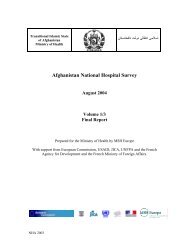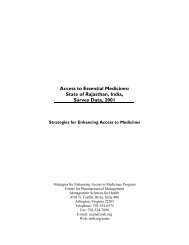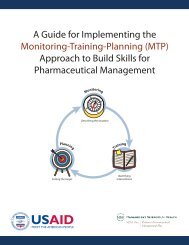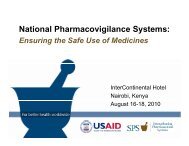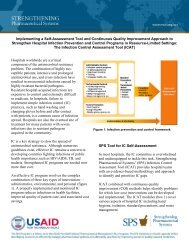CLINIC SUPERVISOR'S MANUAL - Management Sciences for Health
CLINIC SUPERVISOR'S MANUAL - Management Sciences for Health
CLINIC SUPERVISOR'S MANUAL - Management Sciences for Health
Create successful ePaper yourself
Turn your PDF publications into a flip-book with our unique Google optimized e-Paper software.
SECTION 6: REFERRAL SYSTEM GUIDELINES<br />
INTRODUCTION<br />
A fundamental principle of Primary <strong>Health</strong> Care (PHC) is the close relationship between all levels of<br />
the health care system, starting at the community extending upward to clinic, health center and<br />
district hospital and beyond. Each patient is there<strong>for</strong>e connected through a seamless continuum of<br />
services and should arrive at the appropriate level capable of giving optimal health care <strong>for</strong> any<br />
given problem. This assures that the most common and often important measures are available<br />
nearest to home and convenient to each citizen. Through a smoothly functioning referral system, the<br />
patient can arrive at higher levels where more specialized medical professionals as well as<br />
diagnostic and therapeutic tools are available. Thus the referral system is an integral part of PHC.<br />
Effective referral requires clear communication to assure that the patient receives optimal care at<br />
each level of the system. Because the patient is moving between facilities it is the role of the<br />
supervisor to assure that this movement is facilitated and that proper communication accompanies it<br />
in both directions: upward, describing the problem as seen at the lower level facility and requesting<br />
specific help and, importantly, in<strong>for</strong>mation back to the lower level facility describing the findings, the<br />
actions to be taken and the follow up needed.<br />
The referral <strong>for</strong>m is designed to facilitate communication in both directions although effective referral<br />
can occur with written communication on the patient held record or any other convenient paper.<br />
Every patient referred upwards should be accompanied by a written record of the findings, the<br />
questions asked, any treatment given and specific reasons <strong>for</strong> referral and expectations from the<br />
lower level facility. Such communication should accompany the patient (usually carried by the<br />
patient) and a clear designation of to which, facility the patient is being sent. Once the patient is<br />
seen and receives the attention at the higher level facility, back referral to the original facility is of<br />
vital importance. This communication contains answers to the questions posed with specific<br />
findings, special investigations, diagnosis, treatment offered and follow up expected from the lower<br />
level facility. The back referral may be written in the patient held record, but is most usually on a<br />
separate piece of paper, which should be delivered by the patient to the clinic, but may also be sent<br />
by fax or mail to the clinic.<br />
The weakest part of this communication is generally back referral from the higher level facility. This<br />
communication not only assures proper patient care and follow up, but importantly provides<br />
continuing education to the lower level facility and their staff. The supervisor should assure that<br />
such communication occurs and in its absence actually pursue the medical officer at the higher level<br />
facility to seek proper back referral in<strong>for</strong>mation.<br />
The supervisor should review all referrals made from the clinic upwards each month <strong>for</strong> the<br />
appropriateness of the decision to refer. Usually between 5 and 10% of patients seen in the clinic<br />
will be referred to a higher level <strong>for</strong> either diagnostic or more specialized care. The supervisor<br />
should discuss referred cases:<br />
• Identifying those which should have been properly treated at the clinic itself without referral.<br />
• But also identifying cases which should have been referred but were handled locally.<br />
• An important role of the supervisor is to discuss the back referrals received to determine whether<br />
the in<strong>for</strong>mation is adequate and being acted upon by the clinic.<br />
This <strong>for</strong>m of continuing education can be stimulated and rein<strong>for</strong>ced by discussion with the supervisor<br />
to enable the clinic to progressively take over the greater responsibility <strong>for</strong> many of the cases.<br />
Continuing treatment of chronic cases such as diabetes, hypertension, epilepsy and psychiatric<br />
illness is particularly important and assures not only high quality of care <strong>for</strong> the patient, but also<br />
greater convenience and less burden on the higher levels of the system.<br />
A monthly review of referrals upward and back referrals received is an important supervisory<br />
function. Additionally the supervisor should follow up cases that have been referred with no<br />
feedback received to assure that they arrive at the higher level and to determine what actions were<br />
taken and follow up needed at the clinic.<br />
Clinic Supervisor’s Manual 1




